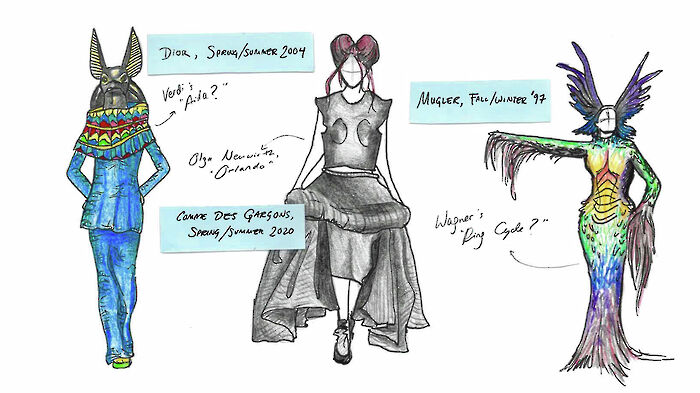Vogue Italia to forgo photos this month in the name of sustainability
With the announcement of the first solely illustrated issue of Vogue Italia, Caterina Bragoli explores the impact of such a radical statement on the industry
Since its birth in 1892, Vogue has been the ultimate source of news for all things fashion. We flock, even now, to the glossy pages, seeking inspiration and words of wisdom from icons like Anna Wintour or Edward Enninful, hoping to emulate some of the untouchable glamour and sophistication that accompanies any editorial role on the Vogue team.
Vogue Italia images veer towards the theatrical, exaggerated and unorthodox
Whilst Vogue reaches all corners of the globe with its various international subdivisions, there is one particular edition that is famed for its avant-garde quality: Vogue Italia. Its covers tend to be free of cover lines and enticing language, rather focusing our attention on the striking cover image, that, more often than not, plays with the boundaries of convention. Although magazine regulars like Kaia Gerber and Elizabeth Grace feature as cover stars, their Vogue Italia images veer towards the theatrical, exaggerated and unorthodox. Supermodel Kendall Jenner graced the February 2019 cover, in an ode to 60s Italian cinema, wearing an expression of romantic shock as her main accessory. They’ve also featured inanimate objects on covers, with a triumph of this being 2009’s ‘The Black Barbie Issue’, paying homage to the ‘forever icon’, as the sole cover line read.
It only feels fitting that Vogue Italia are the ones to take this transgressive approach to covers even further. The magazine has decided to make its January issue photograph-free, in a mission to reduce the effects of “traveling, shipping clothes or polluting”. We, as eager consumers of the magazine, receive the final cover, without knowing the extensive production process that was required to produce it. Editor-in-chief Emanuele Farneti hoped to raise “significant environmental impact associated with publishing a fashion magazine”, both through these covers and the content within the magazine, marking another bold move from the publication. It was estimated by the Vogue Italia editorial team that its September Issue, the fashion Bible’s most crucial issue of the year, took over “150 people” and “20 flights”. The words ‘sustainability’ and ‘fashion’ are rarely heard without each other’s company, yet facts like this are rarely revealed: perhaps we need to shift the discussion away from garment production, and towards mammoth publications.
The illustrations place each magazine on its own artistic plane, providing something ethereal and unique to look at.
It is the way that Vogue Italia have chosen to counteract the issue that is the most inspiring: the cover photography has been replaced with illustrations, echoing the Vogue covers from decades past. Whilst this marks Vogue Italia’s first foray into the world of illustration, it is something that Vogue, particularly the British and French editions, is no stranger to. Renowned covers, such as the woman on the moon, drawn by George Wolfe Plank for the November 1917 issue of British Vogue, can be located on many bedroom walls (mine included). The illustrations place each magazine on its own artistic plane, providing something ethereal and unique to look at, and have the ability to transport you to a vintage cabaret or the streets of Paris in 1949.
The commissioned artists are all strikingly different from each other, which is what makes this venture all the more exciting. We will be treated to the works of the Japanese illustrator Yoshitaka Amano, who has previously worked as a costume designer, a character designer and a film scenic designer. The cover produced by Amano manages to preserve the same vintage feel as covers produced a century ago, with a mystical close up of Lindsey Wixson, drawn primarily in blue. Mozambique-born painter Cassi Namoda, who credits “the most colourful things” as her inspiration, paints Ambar Cristal Zarzuela with tears streaming down her face, wearing Gucci. I wouldn’t be crying wearing Gucci, but each to their own. In any case, its an eclectic cover, featuring clashing colour against a washed-out backdrop. Other artists included Vanessa Beecroft and Milo Manara (who said his cover was inspired by none other than Michaelangelo’s David).
The worlds of fashion and art have coincided in a spectacular vision of colour, design and exploration. Vogue Italia’s latest experiment has paid off massively: the sustainable fashion debate has been rejuvenated for 2020, with a technicoloured transformation. Vogue’s return to illustrated covers, whilst temporary, marks a preservation of the values that fashion has always stood for: timelessness and adaptability. What’s more, Farneti has promised that the pecuniary gain resulting from the lack of photoshoots will be donated to the Fondazione Querini Stampalia restoration fund, a historic Venetian building that was damaged by the city’s November floods.
 Interviews / You don’t need to peak at Cambridge, says Robin Harding31 December 2025
Interviews / You don’t need to peak at Cambridge, says Robin Harding31 December 2025 Comment / What happened to men at Cambridge?31 December 2025
Comment / What happened to men at Cambridge?31 December 2025 News / Unions protest handling of redundancies at Epidemiology Unit30 December 2025
News / Unions protest handling of redundancies at Epidemiology Unit30 December 2025 Features / ‘Treated like we’re incompetent’: ents officers on college micromanagement30 December 2025
Features / ‘Treated like we’re incompetent’: ents officers on college micromanagement30 December 2025 News / Varsity’s biggest stories of 202531 December 2025
News / Varsity’s biggest stories of 202531 December 2025










